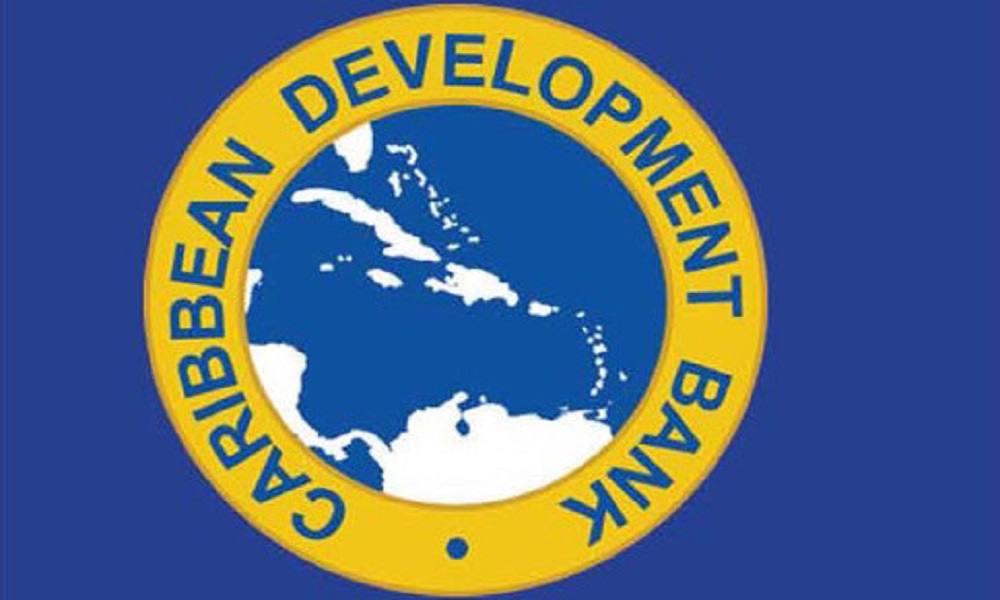
The Barbados-based Caribbean Development Bank (CDB) says despite forecast of deceleration in global economic activity, the 2019 economic outlook for its borrowing member countries (BMCs) is positive, predicting economic growth of more than two per cent.
In its 2018 Annual Report released at the start of the bank’s 49th Annual Board of Governors Meeting, the CDB said the world gross domestic product (GDP) is expected to decline to 3.5 per cent this year, from 3.7 per cent in 2018, and blamed various situations like Britain’s continued efforts to leave the European Union and the economic slowdown in China.
 The CDB, the region’s premier financial institution, said that the Caribbean’s exposure to these risks is high as is its vulnerability to weather-related events. It said in addition, some institutional weaknesses need to be addressed to improve delivery of critical economic and social projects
The CDB, the region’s premier financial institution, said that the Caribbean’s exposure to these risks is high as is its vulnerability to weather-related events. It said in addition, some institutional weaknesses need to be addressed to improve delivery of critical economic and social projects
“Nevertheless, GDP is projected to rise by 2.1 per cent as construction, tourism, and the extractive industries, such as gold and oil, expand.”
The CDB said that Barbados is the only BMC in which economic activity is not expected to increase in 2019 and that ongoing fiscal retrenchment is expected to cancel out strong tourism performance.
“There is upside risk, the realisation of which will depend on the timing of planned private sector projects and increased demand for financial services resulting from strengthening investor confidence.”
It said in the case of Grenada, the island is projected to grow the fastest, with increases in all of its main sectors, especially construction and tourism. These two sectors will also continue to be significant contributors to performance elsewhere.
Hotel capacity in Anguilla and the British Virgin Islands should be closer to the levels before the 2017 hurricanes. Improved project implementation will help the reconstruction effort in Dominica. In these and other BMCs, ongoing public and private reconstruction will be complemented by new developments, including a medical facility in St. Kitts and Nevis, and expansion of the Cayman Enterprise City in the Cayman Islands,” the CDB said.
It said in Jamaica, productivity-enhancing reforms and public investments undertaken as part of the government’s reform programme are expected to contribute to rising domestic demand. At the same time, improvements in agricultural productivity will boost incomes.
In Haiti, additional investment and a more competitive exchange rate will raise the level of activity in the textile industry. Private consumption should be buoyed by a consistent and high level of workers’ remittances from abroad.
Expansion in construction is projected for Guyana, as the country continues to prepare for 2020. The CDB said commercial oil production will potentially lead to double-digit rates of growth in the medium term, and to significant hikes in government revenue.
“It could also have negative effects, such as marginalising other productive industries. Careful stewardship of the oil revenues will be necessary to ensure that Guyana’s development priorities can be addressed. Guyana’s Natural Resources Fund is designed to ensure that such stewardship takes place.”
The CDB is predicting that the elevated activity in Guyana will push up demand for diesel from nearby Suriname, where prospects for further investment in that country’s own oil industry are favourable. However, oil production will temporarily be negatively impacted by maintenance operations.
In Trinidad and Tobago, natural gas production will increase as the new Angelin project comes on stream.
Overall, the CDB said that in 2018, economic performance in the Caribbean was set against a background of slowing global activity. Regional GDP increased by 1.9 per cent compared with 0.5 per cent in 2017.
Fiscal performance varied, and public debt as a percentage of GDP fell in over half of the BMCs. The region is expected to grow by 2.1 per cent in 2019 as traditional industries expand; but in many BMCs the balance of risks is tilted to the downside. Mitigating these risks will continue to require improved resilience on many levels in order to ensure sustainable and inclusive development, the bank noted.
Last year, many Caribbean countries continued the process of rebuilding infrastructure, following the extreme weather events of 2017.
Hurricanes Irma and Maria had affected 10 BMCs to differing extents. Significant hotel damage in Anguilla and the British Virgin Islands meant fall-offs in tourist arrivals of almost 40 and 50 per cent, respectively.
As a result, the Anguillian economy contracted, while expansion in the Virgin Islands was mainly on account of buoyant business and financial services activity. The other eight BMCs affected by these hurricanes also recorded higher levels of GDP, as reconstruction activity complemented improved tourism performance.
The fastest growing economy in 2018 was Grenada, which also achieved a five-year average annual GDP increase of at least five per cent, due to sustained strong performance in construction, tourism, private education and agriculture. In tourism, overnight visitor arrivals were up by more than 10 per cent compared to 2017.
This was also the case in Belize (14.6 per cent) and Cayman Islands (10.7 per cent). Tourism performance also improved in The Bahamas, where the delayed Baha Mar resort was at full capacity for the first full calendar year,; Jamaica; St. Kitts and Nevis; St. Lucia; St. Vincent and the Grenadines; and Turks and Caicos Islands (TCI).
The CDB said that these BMCs also recorded increased construction activity, mostly in the form of investment in public infrastructure, but also new tourist developments
Anguilla and Barbados were the only two countries to experience a fall in real GDP in 2018.
Anguilla’s performance was linked directly to the adverse effects of the 2017 hurricane. Despite modest gains in its tourism sector, Barbados also reported a decline in output. This contraction was attributed to a fall in construction output, and to the implementation of fiscal austerity measures related to the Barbados Economic Recovery and Transformation (BERT) Plan, the Government’s fiscal consolidation programme. Among the commodity exporting countries, rising oil prices drove growth in Suriname and in Trinidad and Tobago. In Suriname, there was also increased investment in the oil sector, predominantly in pre-exploration activity.
In Trinidad and Tobago, manufacturing of petroleum and chemical products rose. Buoyant gold prices also benefitted Suriname, although there was little change in production. Economic expansion in Guyana was linked mainly to construction activity, in advance of the start of commercial oil production in 2020. However, gold extraction fell, due to declining declarations by small and medium-scale miners who faced higher fuel and operational costs. Agricultural output also dropped, reflecting a significant fall in sugar production as restructuring of the industry continued.
Agricultural production expanded in Belize, Haiti and Jamaica. In Belize, fisheries production was lower than the previous year, due to ongoing problems in the disease-affected shrimp industry. Manufacturing contracted in Belize with notable falls in production of juices and soft drinks. A more stable industrial climate helped manufacturing to grow by 1.2 per cent in Haiti.
Fiscal performance varied across the region. Debt as a percentage of GDP decreased in 13 BMCs, but the ratio exceeded the international benchmark of 60 per cent in 11 countries.
Public finances in some BMCs continued to be affected by the fallout from the 2017 hurricanes. Tax revenues fell in Anguilla, while expenditure, much of it related to recovery, rose.
In Antigua and Barbuda, rising public expenditure was accompanied by lower non-tax revenues, especially from the Citizenship by Investment (CBI) programme. Indeed, it was only in St. Kitts and Nevis that CBI revenues rose, following the launch of a new fund in late 2017, the CDB noted.
In Grenada, the fiscal position continued to improve, reflecting strengthened expenditure management and tax compliance. Sustained economic growth contributed to better fiscal performance in Suriname and in Trinidad and Tobago. A tax amnesty in Guyana raised additional revenues amounting to one per cent of GDP.
As part of the first stage of Barbados’ economic recovery programme, debt restructuring and fiscal restraint contributed to a higher primary surplus. Debt interest payments were lower, and there were reductions in transfers and subsidies, particularly to state-owned enterprises. Corporate tax receipts were up; and new taxes were introduced.
Belize also recorded a primary surplus, attributable to revenue enhancement measures taken to meet the targets agreed with creditors as part of its 2017 debt restructuring programme. Most of these measures were amendments to excise duties and to general sales tax to reduce avoidance and improve compliance.
External positions improved in most BMCs, as did the level of foreign reserves. The current account situation strengthened in Suriname and in Trinidad and Tobago due to higher oil and gas prices. Suriname’s external position also benefitted from rising gold prices.
The CDB said that these developments helped the external reserves position to rise above the international benchmark of three months of imports. External loan disbursements improved the reserves position in Barbados.
There were current account deficits in Belize, Guyana and Jamaica, on account of increasing imports, particularly fuel. The deficits were partly funded by foreign direct investment. Notwithstanding, there was a drawdown on foreign reserves in these three BMCs.
“While still comfortably above the three months benchmark in Jamaica, foreign reserves were closer to this threshold than in the other two BMCs,” the CDB reported.
Advertise with the mоѕt vіѕіtеd nеwѕ ѕіtе іn Antigua!
We offer fully customizable and flexible digital marketing packages.
Contact us at [email protected]


















So Grenada is the fastest growing economy in the region and had an increase of 10% of tourist arrivals. An average growth of 5% over 5 years. Wow.
Of all the strong tourist arrivals increases mentioned in the article Antigua the economic powerhouse was left out.
Now we know who is writing up those glowing reports fronting as journalistic articles about Antigua’s economy and quoting those fake agencies that only report the cooked financials submitted by this government. Lies lies and the lying liars who tell them, arwe come last again.
Of all the economic benchmarks highlighted Antigua could only muster high public spending and low revenues and even little St. Kitts beat us again on CIP. Not even our cheap wash you foot and come Passport we can sell now.
Lawd help us.
How about you read the actual report before making yourself a fool? It makes clear that A&B had the 2nd highest increase in GDP in the English speaking Caribbean region. Yes contrary to your sky is falling talks A&B is doing well
“The fastest growing economies were Grenada (5.2%), Antigua
and Barbuda (3.5%) and Guyana (3.4%). ”
https://www.caribank.org/publications-and-resources/resource-library/economic-reviews/regional-economic-summary-2018
Notes From A Native Son Of The Rock! My Haitian Hero, staying confined in the Citadel without exploring along the Caribbean and Lucayan Highways and their off ramps will definitely blind you to a Caribbean Civilization and its Institutions! Do not become MARGINALIZED which is becoming more obvious with the passage of TIME and SPACE! Spend some time and read CDB-AnnualReport-2018_FINAL 5.pdf
“The value of etymology, that is, the origin of terms and words is in the proper identification and location of concepts. The Afrocentrist seeks to demonstrate clarity by exposing dislocations, disorientations, and decenterness. One of the simplest ways of accessing textual clarity is through etymology.” – Asante!
Grenada GRE: “An average growth of 5% over 5 years. Wow”! Which Borrowing Member Country (BMC) was Next! Would you believe Antigua and Barbuda! REAL GDP GROWTH (%) 2018: GRE – 5.2 Next A&B 3.5, BAH 2.2! Not all of the BMC’s Tourism stats were reported! One can get the A&B stats and compare them rather than living blindly!
DEBT-TO-GDP RATIO AS AT END OF 2018 % OF GDP: BAH 57.4 SKN-58.2 A&B-88.2 (OECS High) JAM-97.4 BAR-126.9!
FOREIGN RESERVES (IN MONTHS OF IMPORTS):DOM-13.9 T&T 8.1 SKN 8.0 A&B 7.9 HAI 5.9 GRE 3.4 NOTE BIEN, BAH 3.3!
REAL GDP GROWTH 2019 FORECASTS (%): GRE 4.5 GUY 4.0 A&B, SKN & SLU 3.0 BAH and T&T 2.0 JAM 1.5 BAR 0.0!
For this exercise, the Bahamas, one of Off Ramps on the Lucayan Highway has been listed for comparison!
“Myths tie all relationships together, whether personal or conceptual. It is the Afrocentrist’s task to determine to what extent the myths of society are represented as being central to or marginal to society. This means that any textual analysis must involve the concrete realities of lived experiences, thus making historical experiences a key element in analytica Afrocentricity. In examining attitude, direction, and language the Afrocentrist is seeking to uncover the imagination of the author. What one seeks to do is to create an opportunity for the writer to show where he or she stands in relationship to the subject. Is the writer centered or is the writer marginalized within his own story?” – Asante!
Comments are closed.